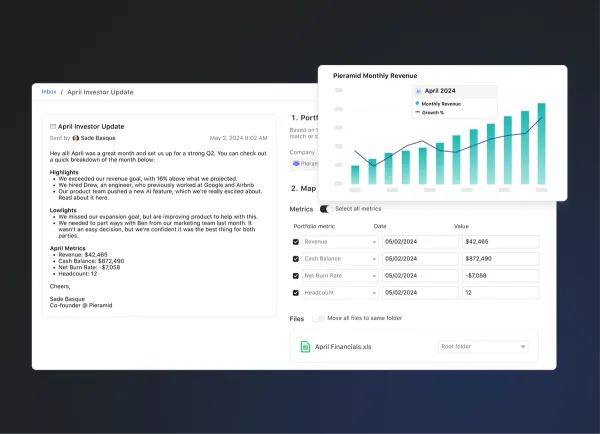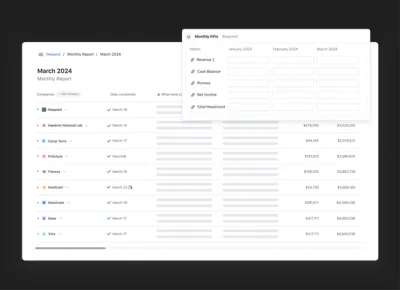
Finding Your SaaS Metrics
The software-as-a-service industry has experienced rapid growth in the past few years. Typical SaaS companies have added staff at rates exceeding 50 percent a year. At the same time, not every SaaS company grows at the same rate. Rapid growth and the nature of this sort of business can also expose startups to certain vulnerabilities that other kinds of companies may not have to contend with.
On the positive side, digital companies should have access to the right SaaS metrics in order to track and manage growth. Take a moment to understand these important performance indicators to make certain they’re properly collected and analyzed. With the explosion of the SaaS industry has come the explosion of the resources and data surrounding the industry. There are more SaaS metrics benchmarks available than ever before to make sure that your company is on the right track.
Related Resource: Check out our free Google Sheet Template to track your key SaaS Metrics here.
Related Resource: How to Start and Operate a Successful SaaS Company
Churn Rates
New companies may focus upon customer acquisition. Still, businesses almost always find they spend less keeping loyal customers than always having to seek new ones. The nature of SaaS billing makes it even more important to ensure customers keep renewing their monthly or annual subscriptions. Typical forecasting depends upon customers keeping their accounts active.
With that in mind, consider a couple of churn rates to track:
- Customer churn rate: This simply refers to customers lost within specific time periods. Hopefully, you can also enhance these SaaS metrics with information about why the churn rate may have either spiked or declined under various circumstances.
- Revenue churn rate: A SaaS business model may include various prices, based upon the number of unique accounts or levels of features or services. Hopefully, customers upgrade over time; however, if they’re not, SaaS companies should find out why.
Customer Value & Cost Metrics
SaaS businesses should track various SaaS metrics that help them compare the costs and revenues associated with acquiring and keeping customers. This helps them understand if they need to improve marketing, retention, and various other areas.
Customer Lifetime Value
You can estimate the lifetime value of your customers by following these steps:
- Estimate your customer lifetime rate with this formula: 1/average churn rate. With an average churn rate of one percent, for example, your CLR would be 100.
- Divide monthly revenue by the number of customers to calculate your average revenue per account, or ARPA. For example, 100 customers and a monthly revenue of $100,000 would work out to an ARPA of $1,000.
- Finally, calculate the customer lifetime value, or CLV, by multiplying the ARPA by the CLR. In the example above, your CLV would be 1,000 X 100 = $100,000.
You can use the CLV to help you estimate the lifetime value of each customer. Companies can also use this handy metric to illustrate their value to investors.
Customer Acquisition Cost
After estimating how much value an average customer contributes to a SaaS business, it’s important to balance that against the price of acquiring them. Obviously, businesses need to compare these two numbers to demonstrate their business model’s viability. To accomplish this SaaS companies track their customer acquisition cost. The customer acquisition cost is the monetary cost it takes to acquire one new customer. Presumably with a SaaS company the cost of acquisition will lower as they acquire more customers. Simply divide all marketing and sales expenses by the number of customers acquired during a given month. If a SaaS company spent $10,000 to gain 10 new accounts, the CAC would be $1,000.
Related Resource: Customer Acquisition Cost: A Critical Metrics for Founders
Months to Recover Acquisition Cost
Figure out how long it takes for a business to recoup their acquisition costs by using customer acquisition cost, monthly gross margin, or MGM, and monthly recurring revenue. Your formula would look like this: CAC / (MGM X MRR).
Acquisition Cost to Lifetime Value Ratio
Such metrics as acquisition costs and lifetime value are only truly informative when compared to each other. Some financial experts will say that your LVR should exceed CAC by a factor of at least three. Ratios closer to one mean that you need to trim expenses. On the other hand, too large of a ratio may mean that you could spend more to gain even more business.
Customer Scores
Since SaaS businesses live and die by their ability to maintain customer subscriptions, they should consider SaaS metrics that help measure how well they keep customers active with their product subscriptions.
For instance:
- Customer engagement: To create a customer engagement score, each business will need to figure out unique measures that apply to their product. Some examples could include how often customers login or stay logged in.
- Customer health — Net Promoter Score: Similarly, companies should create customer health scores using factors that may indicate the likelihood of keeping accounts active or letting them expire. Seeking input from various players, like sales and customer service, can help develop good customer health scores.
Marketing Scores
Since new companies need to focus mostly upon custom acquisition, marketing scores will offer important insights for both marketers and upper management.
These SaaS metrics for marketing include:
- Qualified marketing traffic: As your customer base grows, so will your traffic. For marketing, you need to separate prospects from existing customers when you analyze website visitors.
- Qualified marketing and sales leads: Depending upon the SaaS product, the customer lifecycle can vary considerably. You can work to identify which step in the customer journey your leads are in. For instance, a qualified marketing lead may have already downloaded a marketing eBook or used a free demo. A qualified sales lead may have made a phone call and is ready for another contact.
- Lead-to-customer rate: Sales and marketing can evaluate their effectiveness by analyzing ratios that tell them how many of their leads turn into customers, how long that takes, and so on. Taking steps to improve LTC rates should increase revenues.
Why SaaS Metrics Matter?
Good SaaS companies have a great chance to boom as their business model grows more popular. Still, SaaS companies may have their own vulnerabilities. For instance, some companies struggle to manage rapid growth as much as they might struggle to manage slow growth. While a business onboards many new customers, they also need to keep on eye on pleasing the customers they have already attracted.
At the same time, these digital businesses should have the luxury of easier metric collection. As is illustrated in the examples above, it’s not enough to simply collect gross numbers of website visitors or total revenue. Rapidly growing companies need to find the metrics that will help them make vital business decisions that can improve important business processes. That way, SaaS companies can attract investors, know who to hire, and adjust marketing and sales strategies to acquire and retain their customers.
Related Resource: Top SaaS Products for Startups
Related Resource: Who Funds SaaS Startups?
Related Resource: 20 Best SaaS Tools for Startups
The journey as a SaaS startup founder can often feel like you’re alone on the journey. Finding a reliable SaaS metrics benchmark can be an easy way to see how you are stacking up to your peers. With more data at our fingertips than ever before, there are more SaaS metrics benchmarks and tools available than ever before.




